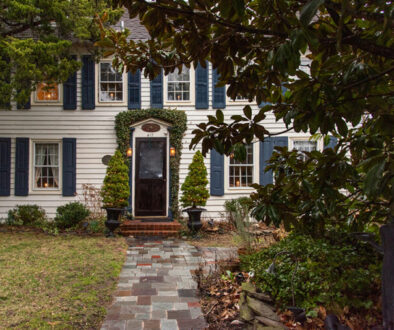Pretty Potagers

The latest reports say that up to 35% of U.S. households are now growing something edible. I find that hard to believe, but what we know for sure is that vegetable gardens are experiencing a revival. Perhaps it’s a natural extension of the Farm to Table movement or maybe it is a result of the pandemic. It is estimated that 18 million new gardeners were created during Covid.
The Case for Growing Your Own
Nothing is better than stepping outside your door and picking a fresh tomato or snipping a few herbs just minutes before you serve them. Talk about farm to table—it just doesn’t get any fresher than that. And we all know that freshness = taste!
Knowing exactly what I am growing and therefore eating is appealing to me. Food that has not been genetically engineered but has been organically fertilized and is pesticide free is not only healthier but tastier. And you can grow your favorite varieties, ensuring you will be able to enjoy what you like, at least in the summertime.
Beautiful Kitchen Gardens
Let’s face it, for the most part vegetable gardens are unattractive. They tend to be row upon row of green leafy plants that more often than not need to be weeded. They are punctuated by some gray metal tomato cages and fenced in with chicken wire to keep out hungry critters. They are almost always square or rectangular and stuck in the backyard someplace—wherever there was enough room.
But there is no reason why your vegetable garden can’t be a feast for your eyes as well as your tummy. Allow me to introduce the concept of a potager—even the word sounds pretty. Pronounced “po-ta-zhay” and derived from the French word potage or soup, potagers are kitchen gardens that combine aesthetics and practicality. They are charming and useful—almost enchanting. But first and foremost, they are functional.
Defined by strong architectural form and often highly symmetrical, potagers combine vegetables, herbs, and fruits with flowers and other ornamentals. Historically, potagers were found on the grounds of large estates—the country counterpart to the grand chateaux parterres of France complete with a staff to maintain and harvest them. However, the concept is perfectly adaptable to today’s smaller spaces. Modern potagers do not need to be formal, regimented spaces made up of squares and triangles. Curves are not only perfectly acceptable but add an element of relaxation and therefore increase their appeal.


Create Your Own
Try to locate your potager right outside your kitchen door so you can quickly pop out and gather what you need to prepare supper plus a handful of fresh flowers for your table—unless of course, that area is completely shady. Kitchen gardens require lots of sun.
Define the space using raised beds, mini boxwood hedges or fencing. Structures like trellises or archways add definition and height but should also be functional. For example, if you include a trellis be sure to plant something edible or decorative to grow up it like roses, mandevilla, or vining (indeterminate) tomatoes. Or invest in a few obelisks to support your tomatoes. Use them as focal points by interspersing them in your garden rather than planting your tomatoes all in a row. You can also add height with small trees. Fruit trees are traditionally planted on the outside edges of a potager but can also be beautiful accents within the garden itself.
Create a sense of enclosure with a flat trellis or lattice panel and think vertically especially if your garden is small. Create a teepee made of string for your pole beans. Add a few hanging baskets and fill them with strawberries or cherry tomatoes- even blueberries! Midnight and Sapphire Cascade are new varieties that have been bred specifically for this purpose. Containers are very useful in a potager. Place them right in your garden beds. Not only will they add interest, but you can move them around as the sun pattern changes throughout the summer.
Pathways are critical. In addition to providing a way for you to travel through the space, they are absolutely necessary for maintenance and harvesting. If your garden is a simple small square raised bed, keep the diameter to a maximum of four feet in order to easily reach in to weed and harvest. If you have a foundation planting or your potager is up against a fence keep it to a maximum of two and half feet deep, depending on how tall you are and how far you can comfortably reach.
Lastly, don’t be afraid to add a sculpture, fountain, gazing ball, or anything other ornamentation you love.

What to Plant
So, what should you grow in a potager? Food you like, of course. It’s not just about planting vegetables. It‘s about growing food and flowers you will use in your kitchen. Start with a few of your favorite veggies and add some herbs, especially perennials like lavender, thyme, sage, oregano, and chives. Italian flat parsley is a must in any herb garden. I use it more than any other and I love the fact that it is a biennial—meaning you only have to plant it every other year.
Fruits like blueberries, raspberries, strawberries, and melons are sweet and easy to grow. Once your berries start to ripen be sure to protect them from wildlife that will steal the fruit before you get to pick it and will deposit colorful droppings that can stain your patio.
Intermingle your cutting garden with your kitchen garden and be sure to include some edible flowers like nasturtiums and pansies. Check specific varieties carefully; not all are edible.
Companion plants are those that protect other plants and act as a natural pesticide. For instance, planting cilantro (Coriandrum sativum) attracts beneficial insects that can benefit tomatoes, peppers, eggplant, potatoes, beans, carrots, cabbage, cauliflower, and kale. Like dill, cilantro is a cool weather herb. Once temps go above eighty-five degrees it tends to bolt. Unless you are growing it only for its foliage, let it bloom, because it will continue to protect its neighbors. Marigolds (Tagetes patula) act in much the same fashion.
How many should you plant? The trick is not to overdo it which is one of the reasons I prefer to use starter plants rather than seeds. Seeds have their place. But for vegetables like tomatoes that need to be started indoors weeks before you move them outside, seeds can be a lot of trouble with disappointing results. Or, you can end up with three dozen plants you don’t know what to do with.


A Word about Water
Veggies, like most annuals, almost always need supplemental water—sometimes twice a day in the heat of summer. This is especially true of delicate seedlings and new plantings. As you know, water is expensive. So, use it selectively. Install a DIY drip irrigation system with a timer and use individual drippers when possible. Try to match their output to the minimum amount necessary. In other words, don’t use a two gallon per hour dripper when a one gallon will do.
The number one reason why people try their hand at vegetable gardening and retire after only one season is that it proves to be much more labor intensive than they bargained for. My advice: start small. Don’t bite off more than you can chew. But don’t limit yourself to just growing herbs on a windowsill or tomatoes in patio pots either. Intermingle some vegetables and herbs into your existing landscape and transform your whole garden into a potager!



